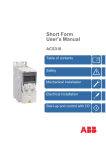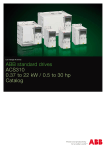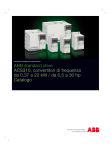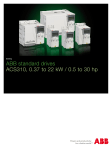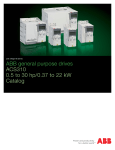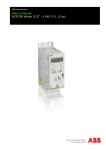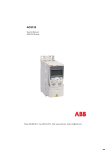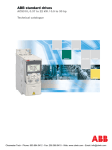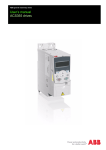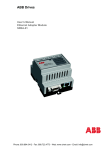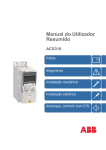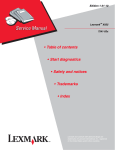Download ACS310 Short User`s Manual
Transcript
Short Form User’s Manual ACS320 Table of contents Safety Mechanical installation Electrical installation Start-up and control with I/O List of related manuals DRIVE MANUALS ACS320 Short Form User’s Manual ACS320 User’s Manual Code (EN) 3AUA0000086933 3AUA0000062599 OPTION MANUALS MFDT-01 FlashDrop User’s Manual MREL-01 Relay Output Extension Module User's Manual for ACS310/ ACS320/ACS350 MUL1-R1 Installation Instructions for ACS150, ACS310, ACS320 and ACS350 MUL1-R3 Installation Instructions for ACS150, ACS310, ACS320 and ACS350 MUL1-R4 Installation Instructions for ACS310, ACS320 and ACS350 SREA-01 Ethernet Adapter Module Quick Start-up Guide SREA-01 Ethernet Adapter Module User’s Manual Code (EN) 3AFE68591074 3AUA0000035974 2) 2) 2) 3AFE68642868 1, 2) 3AFE68643147 1, 2) 3AUA0000025916 1, 2) 3AUA0000042902 2) 3AUA0000042896 3) MAINTENANCE MANUALS Code (EN) Guide for Capacitor Reforming in ACS50, ACS55, ACS150, ACS310, 3AFE68735190 ACS320, ACS350, ACS550 and ACH550 1) Multilingual 2) Delivered as a printed copy with the drive / optional equipment 3) Delivered in PDF format with the drive / optional equipment All manuals are available in PDF format on the Internet. See section Document library on the Internet on page 43. Purpose of the manual This short form user’s manual provides the basic information needed for installing and commissioning the drive. For information on planning the electrical installation, operation with the control panel, program features, fieldbus, all accessible actual signals and parameters, fault tracing, maintenance, additional technical data and dimension drawings, refer to ACS320 User’s Manual (3AUA0000062599 [English]). To access it on the Internet, go to www.abb.com/drives, select Document Library, enter the code in the search field and click OK. Applicability The manual is applicable to the ACS320 drive firmware version 4.03b or later. See parameter 3301 FIRMWARE in chapter Actual signals and parameters in ACS320 User’s Manual (3AUA0000062599 [English]). 3AUA0000086933 Rev A EN EFFECTIVE: 01.08.2010 © 2010 ABB Oy. All Rights Reserved. Table of contents 3 Table of contents List of related manuals . . . . . . . . . . . . . . . . . . . . . . . . . . . . . . . . . . . . . . . . . . . . . . . . . . . . . . . 2 Purpose of the manual . . . . . . . . . . . . . . . . . . . . . . . . . . . . . . . . . . . . . . . . . . . . . . . . . . . . . . . 2 Applicability . . . . . . . . . . . . . . . . . . . . . . . . . . . . . . . . . . . . . . . . . . . . . . . . . . . . . . . . . . . . . . . . 2 1. Safety Safety in installation and maintenance . . . . . . . . . . . . . . . . . . . . . . . . . . . . . . . . . . . . . . . . . . . 5 Safe start-up and operation . . . . . . . . . . . . . . . . . . . . . . . . . . . . . . . . . . . . . . . . . . . . . . . . . . . . 6 2. Hardware description Power connections and control interfaces . . . . . . . . . . . . . . . . . . . . . . . . . . . . . . Safety ........... 7 Type designation key . . . . . . . . . . . . . . . . . . . . . . . . . . . . . . . . . . . . . . . . . . . . . . . . . . . . . . . . . 8 3. Mechanical installation Installing . . . . . . . . . . . . . . . . . . . . . . . . . . . . . . . . . . . . . . . . . . . . . . . . . . . . . . . . . . . . . . . . . . 9 4. Electrical installation Checking the compatibility with IT (ungrounded) and corner grounded TN systems . . . . . . . Connecting the power cables . . . . . . . . . . . . . . . . . . . . . . . . . . . . . . . . . . . . . . . . . . . . . . . . . Connecting the control cables . . . . . . . . . . . . . . . . . . . . . . . . . . . . . . . . . . . . . . . . . . . . . . . . . Installation checklist . . . . . . . . . . . . . . . . . . . . . . . . . . . . . . . . . . . . . . . . . . . . . . . . . . . . . . . . . 13 14 16 18 5. Start-up and control with I/O How to start up the drive . . . . . . . . . . . . . . . . . . . . . . . . . . . . . . . . . . . . . . . . . . . . . . . . . . . . . 19 How to control the drive through the I/O interface . . . . . . . . . . . . . . . . . . . . . . . . . . . . . . . . . . 26 6. Actual signals and parameters in the short view Terms and abbreviations . . . . . . . . . . . . . . . . . . . . . . . . . . . . . . . . . . . . . . . . . . . . . . . . . . . . . Fieldbus equivalent . . . . . . . . . . . . . . . . . . . . . . . . . . . . . . . . . . . . . . . . . . . . . . . . . . . . . . . . . Default values with different macros . . . . . . . . . . . . . . . . . . . . . . . . . . . . . . . . . . . . . . . . . . . . Actual signals in the short parameter view . . . . . . . . . . . . . . . . . . . . . . . . . . . . . . . . . . . . . . . Parameters in the short parameter view . . . . . . . . . . . . . . . . . . . . . . . . . . . . . . . . . . . . . . . . . 27 27 28 31 31 7. Technical data Ratings . . . . . . . . . . . . . . . . . . . . . . . . . . . . . . . . . . . . . . . . . . . . . . . . . . . . . . . . . . . . . . . . . . 37 Power cable sizes and fuses . . . . . . . . . . . . . . . . . . . . . . . . . . . . . . . . . . . . . . . . . . . . . . . . . . 39 UL checklist . . . . . . . . . . . . . . . . . . . . . . . . . . . . . . . . . . . . . . . . . . . . . . . . . . . . . . . . . . . . . . . 40 Further information Product and service inquiries . . . . . . . . . . . . . . . . . . . . . . . . . . . . . . . . . . . . . . . . . . . . . . . . . 43 Product training . . . . . . . . . . . . . . . . . . . . . . . . . . . . . . . . . . . . . . . . . . . . . . . . . . . . . . . . . . . . 43 4 Table of contents Providing feedback on ABB Drives manuals . . . . . . . . . . . . . . . . . . . . . . . . . . . . . . . . . . . . . 43 Document library on the Internet . . . . . . . . . . . . . . . . . . . . . . . . . . . . . . . . . . . . . . . . . . . . . . 43 Safety 5 1. Safety Safety in installation and maintenance These warnings are intended for all who work on the drive, motor cable or motor. Electrical safety WARNING! Ignoring the following instructions can cause physical injury or death, or damage to the equipment. Only qualified electricians are allowed to install and maintain the drive! • Never work on the drive, motor cable or motor when input power is applied. After disconnecting the input power, always wait for 5 minutes to let the intermediate circuit capacitors discharge before you start working on the drive, motor or motor cable. Always ensure by measuring with a multimeter (impedance at least 1 Mohm) that there is no voltage between the drive input phases U1, V1 and W1 and the ground. • Do not work on the control cables when power is applied to the drive or to the external control circuits. Externally supplied control circuits may carry dangerous voltage even when the input power of the drive is switched off. • Do not make any insulation or voltage withstand tests on the drive. • If a drive whose EMC filter is not disconnected is installed on an IT system (an ungrounded power system or a high resistance-grounded [over 30 ohms] power system), the system will be connected to ground potential through the EMC filter capacitors of the drive. This may cause danger or damage the drive. • If a drive whose EMC filter is not disconnected is installed on a corner grounded TN system, the drive will be damaged. • All ELV (extra low voltage) circuits connected to the drive must be used within a zone of equipotential bonding, ie within a zone where all simultaneously accessible conductive parts are electrically connected to prevent hazardous voltages appearing between them. This is accomplished by a proper factory grounding. Note: • Even when the motor is stopped, dangerous voltage is present at the power circuit terminals U1, V1, W1 and U2, V2, W2. 6 Safety General safety WARNING! Ignoring the following instructions can cause physical injury or death, or damage to the equipment. • The drive is not field repairable. Never attempt to repair a malfunctioning drive; contact your local ABB representative or Authorized Service Center for replacement. • Make sure that dust from drilling does not enter the drive during the installation. Electrically conductive dust inside the drive may cause damage or lead to malfunction. • Ensure sufficient cooling. Safe start-up and operation These warnings are intended for all who plan the operation, start up or operate the drive. General safety WARNING! Ignoring the following instructions can cause physical injury or death, or damage to the equipment. • Before adjusting the drive and putting it into service, make sure that the motor and all driven equipment are suitable for operation throughout the speed range provided by the drive. The drive can be adjusted to operate the motor at speeds above and below the speed provided by connecting the motor directly to the power line. • Do not activate automatic fault reset functions if dangerous situations can occur. When activated, these functions will reset the drive and resume operation after a fault. • Do not control the motor with an AC contactor or disconnecting device (disconnecting means); use instead the control panel start and stop keys and or external commands (I/O or fieldbus). The maximum allowed number of charging cycles of the DC capacitors (ie power-ups by applying power) is two per minute and the maximum total number of chargings is 15,000. Note: • If an external source for start command is selected and it is ON, the drive will start immediately after an input voltage break or fault reset unless the drive is configured for 3-wire (a pulse) start/stop. Hardware description 7 2. Hardware description Power connections and control interfaces Control panel (RJ-45) 8 Modbus RTU (RS-232) 1 SCR Screen S1 Reference voltage +10 V DC, max. 10 mA AI1 AI2 2 AI1 Analog input 1 0…10 V 3 GND mA 4 +10V V AO 7 GND 8 Analog output 0…20 mA 5 AI2 Analog input 2 6 GND Aux. voltage output +24 V DC, max. 200 mA 9 +24 V 11 DCOM 12 DI1 PROGRAMMABLE DIGITAL INPUTS 13 DI2 14 DI3 15 DI4 DI5 can also be used as a frequency input PROGRAMMABLE RELAY AND DIGITAL OUTPUTS 10 GND 16 DI5 ROCOM 17 RONC 18 RONO 19 DOSRC 20 DOOUT 21 DOGND 22 Relay output 250 V AC / 30 V DC / 6 A Digital/frequency output, PNP transistor type 30 V DC, max. 100 mA 23 SHIELD Embedded fieldbus (RS-485) 25 A 26 GND_A FlashDrop 6 Output relay module MREL-01 24 B J701 6 EMC EMC filter grounding screw VAR Varistor grounding screw PE L1 3-phase power supply, L2 200…480 V AC L3 1-phase 200...240 V AC U1/L U2 V1/N V2 W1 W2 M 3~ AC motor 8 Hardware description Type designation key The type designation contains information on the specifications and configuration of the drive. You find the type designation on the type designation label attached to the drive. The first digits from the left express the basic configuration, for example ACS320-03E-09A7-4. The optional selections are given after that, separated by + signs, for example +J404. The explanations of the type designation selections are described below. ACS320-03U-08A8-4+J404+... ACS320 product series 3-phase 03 = 3-phase input 01 = 1-phase input Configuration E = EMC filter connected, 50 Hz frequency U = EMC filter disconnected, 60 Hz frequency Output current rating In format xxAy, where xx indicates the integer part and y the fractional part, eg 08A8 means 8.8 A. For more information, see section Ratings on page 37. Input voltage range 2 = 200…240 V AC 4 = 380…480 V AC Options J404 = ACS-CP-C Basic Control Panel 1) J400 = ACS-CP-A Assistant Control Panel 2) R700 = ACS320 User’s Manual in English (3AUA0000062599 [EN]) 1) The ACS320 is compatible with ACS-CP-C Basic Control Panel Rev M or later. 2) The ACS320 is compatible with ACS-CP-B Assistant Control Panel Rev E or later (new panel series manufactured since 2007 with serial number XYYWWRXXXX, where year YY = 07 or greater and revision R = E, F, G, …). Mechanical installation 9 3. Mechanical installation Installing The instructions in this manual cover drives with the IP20 degree of protection. To comply with NEMA 1, use the MUL-R1, MUL-R3 or MUL-R4 option kit, which is delivered with multilingual installation instructions (3AFE68642868, 3AFE68643147 or 3AUA0000025916, respectively). Install the drive Install the drive with screws or on a DIN rail as appropriate. The required free space for cooling above and below the drive is 75 mm (3 in). No free space is required on the sides, so drives can be mounted next to each other. Note: Make sure that dust from drilling does not enter the drive during the installation. With screws 1. Mark the hole locations using for example the mounting template cut out from the package. The locations of the holes are also shown in the drawings in chapter Dimension drawings in ACS320 User’s Manual (3AUA0000062599 [English]). The number and location of the holes used depend on how the drive is installed: a) back mounting (frame sizes R0…R4): four holes b) side mounting (frame sizes R0…R2): three holes; one of the bottom holes is located in the clamping plate. 2. Fix the screws or bolts to the marked locations. 1 2 2 10 Mechanical installation 3. Position the drive onto the screws on the wall. 4. Tighten the screws in the wall securely. 3 4 On DIN rail 1. Click the drive to the rail. To detach the drive, press the release lever on top of the drive (1b). 1 1b Mechanical installation 11 Fasten clamping plates 1. Fasten the clamping plate to the plate at the bottom of the drive with the provided screws. 2. Fasten the I/O clamping plate to the clamping plate (frame sizes R0…R2) with the provided screws. 1 2 12 Mechanical installation Electrical installation 13 4. Electrical installation WARNING! The work described in this chapter may only be carried out by a qualified electrician. Follow the instructions in chapter Safety on page 5. Ignoring the safety instructions can cause injury or death. Make sure that the drive is disconnected from the input power during installation. If the drive is already connected to the input power, wait for 5 minutes after disconnecting the input power. Checking the compatibility with IT (ungrounded) and corner grounded TN systems WARNING! If a drive whose EMC filter is not disconnected is installed on an IT system (an ungrounded power system or a high resistance-grounded [over 30 ohms] power system), the system will be connected to ground potential through the EMC filter capacitors of the drive. This may cause danger or damage the drive. If a drive whose EMC filter is not disconnected is installed on a corner grounded TN system, the drive will be damaged. 1. If you have an IT (ungrounded) or corner grounded TN system, disconnect the internal EMC filter by removing the EMC screw. For 3-phase U-type drives (with type designation ACS320-03U-), the EMC screw is already removed at the factory and replaced by a plastic one. Note: In frame size R4 the EMC screw is located to the right of terminal W2. 1 14 Electrical installation Connecting the power cables Connection diagram Drive PE INPUT U1 V1 W1 OUTPUT U2 V2 W2 1) 2) For alternatives, see chapter Planning the electrical installation, section Selecting the supply disconnecting device (disconnecting means) in ACS320 User’s Manual (3AUA0000062599 [English]). PE U1 V1 W1 3~ Motor L1 L2 L3 1) Ground the other end of the PE conductor at the distribution board. 2) Use a separate grounding cable if the conductivity of the cable shield is insufficient (smaller than the conductivity of the phase conductor) and there is no symmetrically constructed grounding conductor in the cable. See chapter Planning the electrical installation, section Selecting the power cables in ACS320 User’s Manual (3AUA0000062599 [English]). Note: Do not use an asymmetrically constructed motor cable. If there is a symmetrically constructed grounding conductor in the motor cable in addition to the conductive shield, connect the grounding conductor to the grounding terminal at the drive and motor ends. Route the motor cable, input power cable and control cables separately. For more information, see chapter Planning the electrical installation, section Routing the cables in ACS320 User’s Manual (3AUA0000062599 [English]). Grounding of the motor cable shield at the motor end For minimum radio frequency interference: • ground the cable by twisting the shield as follows: flattened width > 1/5 · length • or ground the cable shield 360 degrees at the leadthrough of the motor terminal box. b > 1/5 · a a b Electrical installation 15 Connection procedure 1. Fasten the grounding conductor (PE) of the input power cable under the grounding clamp. Connect the phase conductors to the U1, V1 and W1 terminals. Use a tightening torque of 0.8 N·m (7 lbf·in) for frame sizes R0…R2, 1.7 N·m (15 lbf·in) for R3, and 2.5 N·m (22 lbf·in) for R4. 2. Strip the motor cable and twist the shield to form as short a pigtail as possible. Fasten the twisted shield under the grounding clamp. Connect the phase conductors to the U2, V2 and W2 terminals. Use a tightening torque of 0.8 N·m (7 lbf·in) for frame sizes R0…R2, 1.7 N·m (15 lbf·in) for R3, and 2.5 N·m (22 lbf·in) for R4. 3. Secure the cables outside the drive mechanically. 1 1 2 2 2 16 Electrical installation Connecting the control cables Default I/O connection diagram The default connection of the control signals depends on the application macro in use, which is selected with parameter 9902 APPLIC MACRO. The default macro is the HVAC Default macro. It provides a general purpose I/O configuration with one constant speed. Parameter values are the default values given in chapter Actual signals and parameters in ACS320 User’s Manual (3AUA0000062599 [English]). The default I/O connections for the HVAC Default macro are given in the figure below. 1…10 kohm max. 500 ohm 1) X1A 1 SCR 2 AI1 3 GND 4 +10V 5 AI2 6 GND 7 AO 8 GND 9 +24V 10 GND 11 DCOM 12 DI1 13 DI2 14 DI3 15 DI4 16 DI5 X1B 17 ROCOM 18 RONC 19 RONO 20 DOSRC 21 DOOUT 22 DOGND See parameter group 12 CONSTANT SPEEDS: DI3 Operation (parameter) 0 Set speed through AI1 1 Speed 1 (1202) Signal cable shield (screen) External reference: 0…10 V or 0...20 mA Analog input circuit common Reference voltage: +10 V DC, max. 10 mA PID feedback 0…10 V or 0...20 mA Analog input circuit common Output frequency value: 0…20 mA Analog output circuit common Auxiliary voltage output: +24 V DC, max. 200 mA Auxiliary voltage output common Digital input common Stop (0) / Start (1) Not Configured Constant speed selection 1) Safety Interlock Not Configured Relay output 1 Default operation: Ready Digital output, max. 100 mA No fault [Fault (-1)] Electrical installation 17 Connection procedure 1. Remove the terminal cover by simultaneously pushing the recess and sliding the cover off the frame. 2. Digital signals: Strip the outer insulation of the digital signal cable 360 degrees and ground the bare shield under the clamp. 3. Connect the conductors of the cable to the appropriate terminals. Use a tightening torque of 0.4 N·m (3.5 lbf·in). 4. For double-shielded cables, twist also the grounding conductors of each pair in the cable together and connect the bundle to the SCR terminal (terminal 1). 4 4 3 2 1 2 5. Analog signals: Strip the outer insulation of the analog signal cable 360 degrees and ground the bare shield under the clamp. 6. Connect the conductors to the appropriate terminals. Use a tightening torque of 0.4 N·m (3.5 lbf·in). 7. Twist the grounding conductors of each pair in the analog signal cable together and connect the bundle to the SCR terminal (terminal 1). 8. Secure all cables outside the drive mechanically. 9. Slide the terminal cover back in place. 6 4 7 7 5 5 9 18 Electrical installation Installation checklist Check the mechanical and electrical installation of the drive before start-up. Go through the checklist below together with another person. Read chapter Safety on page 5 before you work on the drive. Check MECHANICAL INSTALLATION The ambient operating conditions are allowed. (See Technical data: Losses, cooling data and noise and Ambient conditions in ACS320 User’s Manual (3AUA0000062599 [English]).) The drive is fixed properly on an even vertical non-flammable wall. (See Mechanical installation on page 9 and Mechanical installation in ACS320 User’s Manual (3AUA0000062599 [English]).) The cooling air will flow freely. (See Mechanical installation: Install the drive on page 9.) The motor and the driven equipment are ready for start. (See Planning the electrical installation: Checking the compatibility of the motor and drive as well as Technical data: Motor connection data in ACS320 User’s Manual (3AUA0000062599 [English]).) ELECTRICAL INSTALLATION (See Electrical installation on page 13 and Planning the electrical installation in ACS320 User’s Manual (3AUA0000062599 [English]).) For ungrounded and corner grounded systems: The internal EMC filter is disconnected (EMC screw removed). The capacitors are reformed if the drive has been stored over a year. The drive is grounded properly. The input power voltage matches the drive nominal input voltage. The input power connections at U1, V1 and W1 are OK and tightened with the correct torque. Appropriate input power fuses and disconnector are installed. The motor connections at U2, V2 and W2 are OK and tightened with the correct torque. The motor cable, input power cable and control cables are routed separately. The external control (I/O) connections are OK. The input power voltage cannot be applied to the output of the drive (with a bypass connection). Terminal cover and, for NEMA 1, hood and connection box, are in place. Start-up and control with I/O 19 5. Start-up and control with I/O How to start up the drive WARNING! The start-up may only be carried out by a qualified electrician. The safety instructions given in chapter Safety on page 5 must be followed during the start-up procedure. The drive will start up automatically at power up if the external run command is on and the drive is in the remote control mode. Check that the starting of the motor does not cause any danger. De-couple the driven machine if there is a risk of damage in case of incorrect direction of rotation. Note: By default, parameter 1611 PARAMETER VIEW is set to 2 (SHORT VIEW), and you cannot see all actual signals and parameters. To be able to view them, set parameter 1611 PARAMETER VIEW to 3 (LONG VIEW). • Check the installation. See the checklist in chapter Installation checklist in ACS320 User’s Manual (3AUA0000062599 [English]). How you start up the drive depends on the control panel you have. • If you have a Basic Control Panel, follow the instructions given in section How to perform a manual start-up on page 20. • If you have an Assistant Control Panel, you can either run the Start-up Assistant (see section How to perform a guided start-up on page 23) or perform a manual start-up (see section How to perform a manual start-up on page 20). The Start-up Assistant, which is included in the Assistant Control Panel only, guides you through all essential settings to be done. In the manual start-up, the drive gives no guidance; you go through the very basic settings by following the instructions given in section How to perform a manual start-up on page 20. 20 Start-up and control with I/O How to perform a manual start-up For the manual start-up, you can use the Basic Control Panel or the Assistant Control Panel. The instructions below are valid for both control panels, but the displays shown are the Basic Control Panel displays, unless the instruction applies to the Assistant Control Panel only. Before you start, ensure that you have the motor nameplate data on hand. POWER-UP Apply input power. The Basic Control Panel powers up into the Output mode. The Assistant Control Panel asks if you want to EXIT run the Start-up Assistant. If you press , the Start-up Assistant is not run, and you can continue with manual start-up in a similar manner as described below for the Basic Control Panel. REM OUTPUT 00 . Hz FWD CHOICE OFF Do you want to use the start-up assistant? Yes No 00:00 OK EXIT MANUAL ENTRY OF START-UP DATA (parameter group 99) If you have an Assistant Control Panel, select the PAR EDIT OFF language (the Basic Control Panel does not 9901 LANGUAGE support languages). See parameter 9901 for the ENGLISH values of the available language alternatives. [0] For instructions on how to set parameters with the Assistant Control Panel, see chapter Control panels, section Assistant Control Panel in ACS320 User’s Manual (3AUA0000062599 [English]). Enter the motor data from the motor nameplate: ABB Motors 3 motor V 690 Y 400 D 660 Y 380 D 415 D 440 D Cat. no M2AA 200 MLA 4 IEC 200 M/L 55 No Ins.cl. F IP 55 Hz kW r/min A cos IA/IN t E/s 30 1475 32.5 0.83 50 56 50 1475 0.83 30 50 1470 34 0.83 380 V 30 30 1470 59 0.83 50 supply 1475 50 54 0.83 30 voltage 35 1770 59 0.83 60 3GAA 202 001 - ADA 6312/C3 6210/C3 180 IEC 34-1 CANCEL 00:00 SAVE Note: Set the motor data to exactly the same value as on the motor nameplate. For example, if the motor nominal speed is 1440 rpm on the nameplate, setting the value of parameter 9908 MOTOR NOM SPEED to 1500 rpm results in the wrong operation of the drive. Start-up and control with I/O 21 • motor nominal voltage (parameter 9905) Setting of parameter 9905 is shown below as an example of parameter setting with the Basic Control Panel. You find more detailed instructions in chapter Control panels, section Basic Control Panel in ACS320 User’s Manual (3AUA0000062599 [English]). REM PAR 1. To go to the Main menu, press if the bottom line shows OUTPUT; otherwise press repeatedly until you see MENU at the bottom. REM 2. Press keys press . REM / 4. Find the appropriate parameter in the group with keys / . REM REM 5. Press and hold for about two seconds until the parameter value is shown with SET under the value. REM FWD rEF -019901 9905 400 380 9905 MENU until you see “PAr”, and 3. Find the appropriate parameter group with keys / and press . 9905 FWD PAR FWD PAR FWD PAR FWD V PAR SET FWD 6. Change the value with keys / . The value changes faster while you keep the key pressed down. 7. Save the parameter value by pressing REM PAR SET FWD . REM PAR FWD Enter the rest of the motor data: • motor nominal current (parameter 9906) Allowed range: 0.2…2.0 · I2N A REM • motor nominal frequency (parameter 9907) REM • motor nominal speed (parameter 9908) REM • motor nominal power (parameter 9909) REM Select the application macro (parameter 9902) according to how the control cables are connected. The default value 1 (HVAC DEFAULT) is suitable in most cases. REM 9906 9907 9908 9909 9902 PAR FWD PAR FWD PAR FWD PAR FWD PAR FWD V 22 Start-up and control with I/O DIRECTION OF THE MOTOR ROTATION Check the direction of the motor rotation. • If the drive is in remote control (REM shown on the left), switch to local control by pressing LOC REM . xxx . LOC SET FWD if the bottom • To go to the Main menu, press line shows OUTPUT; otherwise press repeatedly until you see MENU at the bottom. • Press keys press . / until you see “rEF” and • Increase the frequency reference from zero to a small value with key . • Press to start the motor. • Check that the actual direction of the motor is the same as indicated on the display (FWD means forward and REV reverse). • Press forward direction to stop the motor. reverse direction To change the direction of the motor rotation: • If parameter 9914 PHASE INVERSION is not visible, first set parameter 1611 PARAMETER VIEW to 3 (LONG VIEW). LOC • Invert the phases by changing the value of parameter 9914 to the opposite, ie from 0 (NO) to 1 (YES), or vice versa. LOC • Verify your work by applying input power and repeating the check as described above. Set parameter 9914 back to 2 (SHORT VIEW). FINAL CHECK Check that the drive state is OK. Basic Control Panel: Check that there are no faults or alarms shown on the display. If you want to check the LEDs on the front of the drive, switch first to remote control (otherwise a fault is generated) before removing the panel and verifying that the red LED is not lit and the green LED is lit but not blinking. Assistant Control Panel: Check that there are no faults or alarms shown on the display and that the panel LED is green and does not blink. The drive is now ready for use. 1611 9914 PAR FWD PAR FWD Hz Start-up and control with I/O 23 How to perform a guided start-up To be able to perform the guided start-up, you need the Assistant Control Panel. Before you start, ensure that you have the motor nameplate data on hand. POWER-UP Apply input power. The control panel first asks if you want to use the Start-up Assistant. OK • Press (when Yes is highlighted) to run the Start-up Assistant. EXIT • Press if you do not want to run the Start-up Assistant. OK • Press key to highlight No and then press if you want to make the panel ask (or not ask) the question about running the Start-up Assistant again the next time you switch on the power to the drive. OFF CHOICE Do you want to use the start-up assistant? Yes No 00:00 OK EXIT CHOICE OFF Show start-up assistant on next boot? Yes No 00:00 EXIT OK SELECTING THE LANGUAGE If you decided to run the Start-up Assistant, the PAR EDIT OFF display then asks you to select the language. Scroll 9901 LANGUAGE to the desired language with keys / and ENGLISH SAVE press to accept. [0] If you press EXIT , the Start-up Assistant is stopped. EXIT 00:00 SAVE STARTING THE GUIDED SET-UP The Start-up Assistant now guides you through the PAR EDIT OFF set-up tasks, starting with the motor set-up. Set the 9905 MOTOR NOM VOLT motor data to exactly the same value as on the motor 220 V nameplate. Scroll to the desired parameter value with keys / SAVE and press to accept and continue with the Start-up Assistant. EXIT 00:00 SAVE EXIT Note: At any time, if you press , the Start-up Assistant is stopped and the display goes to the Output mode. The basic start-up is now completed. However, it might be useful at this stage to set the parameters required by your application and continue with the application set-up as suggested by the Start-up Assistant. CHOICE OFF Do you want to continue with application setup? Continue Skip 00:00 OK EXIT 24 Start-up and control with I/O Select the application macro according to which the control cables are connected. OFF PAR EDIT 9902 APPLIC MACRO HVAC DEFAULT [1] EXIT Continue with the application set-up. After completing a set-up task, the Start-up Assistant suggests the next one. OK • Press (when Continue is highlighted) to continue with the suggested task. 00:00 SAVE OFF CHOICE Do you want to continue with EXT1 reference setup? Continue Skip 00:00 OK EXIT • Press key to highlight Skip and then press OK to move to the following task without doing the suggested task. • Press EXIT to stop the Start-up Assistant. DIRECTION OF THE MOTOR ROTATION Check the direction of the motor rotation. • If the drive is in remote control (AUTO shown on the status line), switch to local control by pressing . • If you are not in the Output mode, press repeatedly until you get there. OFF EXIT xx.xHz xx.x Hz x.x A xx.x % 00:00 DIR MENU • Increase the frequency reference from zero to a small value with key . • Press to start the motor. • Check that the actual direction of the motor is the same as indicated on the display ( means forward and reverse). • Press to stop the motor. forward direction reverse direction To change the direction of the motor rotation: • If parameter 9914 PHASE INVERSION is not visible, first set parameter 1611 PARAMETER VIEW to 3 (LONG VIEW). OFF PAR EDIT 1611 PARAMETER VIEW LONG VIEW [3] CANCEL 00:00 • Invert the phases by changing the value of parameter 9914 to the opposite, ie from 0 (NO) to 1 (YES), or vice versa. OFF • Verify your work by applying input power and repeating the check as described above. [1] CANCEL 00:00 • Set parameter 9914 back to 2 (SHORT VIEW). SAVE PAR EDIT 9914 PHASE INVERSION YES SAVE Start-up and control with I/O 25 FINAL CHECK After the whole set-up is completed, check that there are no faults or alarms shown on the display and the panel LED is green and does not blink. The drive is now ready for use. 26 Start-up and control with I/O How to control the drive through the I/O interface The table below instructs how to operate the drive through the digital and analog inputs when: • the motor start-up is performed, and • the default (standard) parameter settings are valid. Displays of the Basic Control Panel are shown as an example. PRELIMINARY SETTINGS If you need to change the direction of rotation, check that parameter 1003 DIRECTION is set to 3 (REQUEST). Ensure that the control connections are wired according to the connection diagram given for the HVAC Default macro. See section Default I/O connection diagram on page 16. Ensure that the drive is in remote control. Press key LOC REM to switch between remote and local control. In remote control, the panel display shows text REM. STARTING AND CONTROLLING THE SPEED OF THE MOTOR Start by switching digital input DI1 on. Basic Control Panel: Text FWD starts flashing fast and stops after the setpoint is reached REM OUTPUT 00 . Hz 500 . Hz FWD Assistant Control Panel: The arrow starts rotating. It is dotted until the setpoint is reached. Regulate the drive output frequency (motor speed) by adjusting the voltage of analog input AI1. REM OUTPUT FWD CHANGING THE DIRECTION OF ROTATION OF THE MOTOR Reverse direction: Switch digital input DI2 on. REM OUTPUT Forward direction: Switch digital input DI2 off. REM OUTPUT STOPPING THE MOTOR Switch digital input DI1 off. The motor stops. Basic Control Panel: Text FWD starts flashing slowly. Assistant Control Panel: The arrow stops rotating. REM OUTPUT 500 . 500 . Hz REV Hz FWD 00 . FWD Hz Actual signals and parameters in the short view 27 6. Actual signals and parameters in the short view Note: When the control panel is in the short parameter view, ie when parameter 1611 PARAMETER VIEW is set to 2 (SHORT VIEW), the control panel only shows a subset of all signals and parameters. These signals and parameters are described in this chapter. To be able to view all actual signals and parameters, set parameter 1611 PARAMETER VIEW to 3 (LONG VIEW). For the description of all actual signals and parameters, refer to chapter Actual signals and parameters in ACS320 User’s Manual (3AUA0000062599 [English]). Terms and abbreviations Term Definition Actual signal Signal measured or calculated by the drive. Can be monitored by the user. No user setting possible. Groups 01…04 contain actual signals. Def Parameter default value Parameter A user-adjustable operation instruction of the drive. Groups 10…99 contain parameters. Note: Parameter selections are shown on the Basic Control Panel as integer values. Eg parameter 1001 EXT1 COMMANDS selection COMM is shown as value 10 (which is equal to the fieldbus equivalent FbEq). FbEq Fieldbus equivalent: The scaling between the value and the integer used in serial communication. E Refers to types 03E- with European parametrization U Refers to types 03U- with US parametrization Fieldbus equivalent Example: If 2008 MAXIMUM FREQ (see page 32) is set from an external control system, an integer value of 1 corresponds to 0.1 Hz. All the read and sent values are limited to 16 bits (-32768…32767). 28 Actual signals and parameters in the short view Default values with different macros When application macro is changed (9902 APPLIC MACRO), the software updates the parameter values to their default values. The tables below include the parameter default values for different macros. For other parameters, the default values are the same for all macros. See the parameter list starting on page 31 in this manual and chapter Actual signals and parameters in ACS320 User’s Manual (3AUA0000062599 [English]). Actual signals and parameters in the short view 29 Index Name/Selection 9902 APPLIC MACRO HVAC DEFAULT EXT1 DI1 COMMANDS EXT2 DI1 COMMANDS EXT1/EXT2 SEL EXT1 REF1 SEL AI1 REF2 SEL PID1OUT CONST SPEED DI3 SEL RELAY OUTPUT READY 1 RUN ENABLE NOT SEL START ENABLE DI4 1 START ENABLE NOT SEL 2 MINIMUM FREQ 0.0 Hz START SCAN FUNCTION START START INHIBIT OFF ACCELER TIME 1 30.0 s DECELER TIME 1 30.0 s SIGNAL 3 AI 1 PARAM SIGNAL 3 MIN -100.0% SIGNAL 3 MAX 100.0% OUTPUT 3 DSP mA UNIT OUTPUT 3 MIN 0.0 mA OUTPUT 3 MAX 20.0 mA TIMERS ENABLE NOT SEL BOOST SEL NOT SEL TIMER 1 SRC NOT SEL 1001 1002 1102 1103 1106 1201 1401 1601 1608 1609 2007 2101 2108 2202 2203 3415 3416 3417 3419 3420 3421 3601 3622 3626 4005 4010 4011 4027 4110 4111 5303 5304 5305 8109 8110 8111 8123 ERROR VALUE INV SETPOINT SEL INTERNAL SETPNT PID 1 PARAM SET SETPOINT SEL INTERNAL SETPNT EFBBAUD RATE EFB PARITY EFB CTRL PROFILE START FREQ 1 START FREQ 2 START FREQ 3 PFA ENABLE HVAC default Supply Fan Return Fan RETURN FAN DI1 Cooling Condenser Tower Fan CLNG TWR CONDENSER FAN DI1 DI1 SUPPLY FAN DI1 Booster Pump Pump Fan Internal Alternation Timer BOOSTER PUMP PUMP ALTERNA DI1 DI1 INT TIMER TIMER1 DI1 DI1 DI1 DI1 DI1 DI1 TIMER1 EXT1 AI1 PID1OUT DI3 EXT1 AI1 PID1OUT DI3 EXT1 AI1 PID1OUT DI3 EXT1 AI1 PID1OUT DI3 EXT1 AI1 PID1OUT DI3 EXT1 AI1 PID1OUT NOT SEL EXT1 AI1 PID1OUT NOT SEL STARTED STARTED READY READY READY PFA STARTED DI2 DI4 NOT SEL DI4 NOT SEL DI4 NOT SEL DI4 NOT SEL DI4 NOT SEL NOT SEL DI2 DI4 DI5 DI5 NOT SEL NOT SEL NOT SEL NOT SEL DI5 0.0 Hz SCAN START OFF 30.0 s 30.0 s AI 1 0.0 Hz SCAN START OFF 30.0 s 30.0 s AI 1 20.0 Hz SCAN START OFF 30.0 s 30.0 s AI 1 0.0 Hz SCAN START OFF 30.0 s 30.0 s AI 1 0.0 Hz AUTO 0.0 Hz AUTO OFF 10.0 s 10.0 s AI 1 OFF 10.0 s 10.0 s AI 1 0.0 Hz SCAN START OFF 30.0 s 30.0 s AI 1 -100.0% 100.0% mA -100.0% 100.0% mA -100.0% 100.0% mA -100.0% 100.0% mA -100.0% 100.0% mA -100.0% 100.0% mA -100.0% 100.0% mA 0.0 mA 20.0 mA NOT SEL NOT SEL NOT SEL 0.0 mA 20.0 mA NOT SEL NOT SEL NOT SEL 0.0 mA 20.0 mA NOT SEL NOT SEL NOT SEL 0.0 mA 20.0 mA NOT SEL NOT SEL NOT SEL 0.0 mA 20.0 mA NOT SEL NOT SEL NOT SEL 0.0 mA 20.0 mA NOT SEL NOT SEL NOT SEL NO NO NO YES YES NO NO 0.0 mA 20.0 mA DI1 DI3 (B+P3+P2 +P1) NO KEYPAD 40.0% KEYPAD 40.0% KEYPAD 40.0% KEYPAD 40.0% KEYPAD 40.0% KEYPAD 40.0% KEYPAD 40.0% KEYPAD 40.0% SET 1 SET 1 SET 1 SET 1 SET 1 SET 1 SET 1 SET 1 KEYPAD 40.0% KEYPAD 40.0% KEYPAD 40.0% KEYPAD 40.0% KEYPAD 40.0% KEYPAD 40.0% KEYPAD 40.0% KEYPAD 40.0% 9.6 kb/s 8 NONE 1 ABB DRV LIM 60.0 Hz 60.0 Hz 60.0 Hz NOT SEL 9.6 kb/s 8 NONE 1 ABB DRV LIM 60.0 Hz 60.0 Hz 60.0 Hz NOT SEL 9.6 kb/s 8 NONE 1 ABB DRV LIM 60.0 Hz 60.0 Hz 60.0 Hz NOT SEL 9.6 kb/s 8 NONE 1 ABB DRV LIM 60.0 Hz 60.0 Hz 60.0 Hz NOT SEL 9.6 kb/s 8 NONE 1 ABB DRV LIM 60.0 Hz 60.0 Hz 60.0 Hz NOT SEL 9.6 kb/s 8 NONE 1 ABB DRV LIM 60.0 Hz 60.0 Hz 60.0 Hz NOT SEL 9.6 kb/s 8 NONE 1 ABB DRV LIM 58.0 Hz 58.0 Hz 58.0 Hz ACTIVE 9.6 kb/s 8 NONE 1 ABB DRV LIM 60.0 Hz 60.0 Hz 60.0 Hz NOT SEL 30 Actual signals and parameters in the short view Index 9902 1001 1002 1102 1103 1106 1201 1401 1601 1608 1609 2007 2101 2108 2202 2203 3415 3416 3417 3419 3420 3421 3601 3622 3626 4005 4010 4011 4027 4110 4111 5303 5304 5305 8109 8110 8111 8123 Name/Selection Internal Timer w/ Constant Speeds APPLIC MACRO INT TIMER CS EXT1 COMMANDS EXT2 COMMANDS EXT1/EXT2 SEL REF1 SEL REF2 SEL CONST SPEED SEL RELAY OUTPUT 1 RUN ENABLE START ENABLE 1 START ENABLE 2 MINIMUM FREQ START FUNCTION START INHIBIT ACCELER TIME 1 DECELER TIME 1 SIGNAL 3 PARAM SIGNAL 3 MIN SIGNAL 3 MAX OUTPUT 3 DSP UNIT OUTPUT 3 MIN OUTPUT 3 MAX TIMERS ENABLE BOOST SEL TIMER 1 SRC ERROR VALUE INV SETPOINT SEL INTERNAL SETPNT PID 1 PARAM SET SETPOINT SEL INTERNAL SETPNT EFBBAUD RATE EFB PARITY EFB CTRL PROFILE START FREQ 1 START FREQ 2 START FREQ 3 PFA ENABLE Floating Point Hand Control E-Clipse HAND CONTROL NOT SEL E-CLIPSE DI1 FLOATING PNT DI1 Dual Setpoint Dual Setpoint E-Bypass PID PID w/ Constant Speeds DUAL DL SP PID CS E-BYPASS SETPPID DI1 DI1 DI1 NOT SEL DI1 DI1 DI1 DI1 NOT SEL COMM EXT1 KEYPAD AI2 TIMER1 EXT1 DI4U, 5D PID1OUT DI3 EXT1 AI1 PID1OUT NOT SEL DI2 AI1 PID1OUT DI4, 5 EXT1 AI1 PID1OUT NOT SEL EXT1 AI1 AI2 NOT SEL EXT1 AI1 PID1OUT NOT SEL STARTED STARTED STARTED READY STARTED READY READY DI2 DI4 DI2 DI4 DI2 DI4 NOT SEL NOT SEL DI2 NOT SEL NOT SEL NOT SEL COMM COMM DI5 NOT SEL DI5 NOT SEL NOT SEL NOT SEL NOT SEL 0.0 Hz SCAN START OFF 30.0 s 30.0 s TORQUE 0.0 Hz SCAN START OFF 30.0 s 30.0 s TORQUE 0.0 Hz SCAN START OFF 30.0 s 30.0 s AI 1 0.0 Hz SCAN START ON 30.0 s 30.0 s AI 1 0.0 Hz SCAN START OFF 30.0 s 30.0 s AI 1 0.0 Hz SCAN START OFF 30.0 s 30.0 s NOT SEL 0.0 Hz SCAN START OFF 30.0 s 30.0 s AI 1 -200.0% 200.0% % -200.0% 200.0% % -100.0% 100.0% mA -100.0% 100.0% mA -100.0% 100.0% mA 0 0 NO UNIT -100.0% 100.0% mA -200.0% 200.0% DI1 DI3 (B+P3+P2+P1) NO -200.0% 200.0% NOT SEL NOT SEL NOT SEL NO 0.0 mA 20.0 mA NOT SEL NOT SEL NOT SEL NO 0.0 mA 20.0 mA NOT SEL NOT SEL NOT SEL NO 0.0 mA 20.0 mA NOT SEL NOT SEL NOT SEL NO 0.0 0.0 NOT SEL NOT SEL NOT SEL NO 0.0 mA 20.0 mA NOT SEL NOT SEL NOT SEL NO AI1 40.0% KEYPAD 40.0% INTERNAL 50.0% INTERNAL 50.0% KEYPAD 40.0% AI1 40.0% KEYPAD 40.0% SET 1 SET 1 DI3 DI3 SET 1 SET 1 SET 1 AI1 40.0% KEYPAD 40.0% INTERNAL 100.0% INTERNAL 100.0% KEYPAD 40.0% AI1 40.0% KEYPAD 40.0% 9.6 kb/s 8 NONE 1 ABB DRV LIM 60.0 Hz 60.0 Hz 60.0 Hz NOT SEL 9.6 kb/s 8 NONE 1 ABB DRV LIM 60.0 Hz 60.0 Hz 60.0 Hz NOT SEL 9.6 kb/s 8 NONE 1 ABB DRV LIM 60.0 Hz 60.0 Hz 60.0 Hz NOT SEL 9.6 kb/s 8 NONE 1 ABB DRV LIM 60.0 Hz 60.0 Hz 60.0 Hz NOT SEL 9.6 kb/s 8 NONE 1 ABB DRV LIM 60.0 Hz 60.0 Hz 60.0 Hz NOT SEL 9.6 kb/s 8 NONE 1 ABB DRV LIM 60.0 Hz 60.0 Hz 60.0 Hz NOT SEL 76.8 kb/s 8 EVEN 1 DCU PROFILE 60.0 Hz 60.0 Hz 60.0 Hz NOT SEL COMM Actual signals and parameters in the short view 31 Actual signals in the short parameter view Actual signals No. Name/Value Description FbEq 04 FAULT HISTORY Fault history (read-only) 0401 LAST FAULT Code of the latest fault. See chapter Fault tracing in ACS320 1 = 1 User’s Manual (3AUA0000062599 [English]) for the codes. 0 = Fault history is clear (on panel display = NO RECORD). Parameters in the short parameter view Parameters No. Name/Value Description 11 REFERENCE SELECT Panel reference type, external control location selection and external reference sources and limits 1105 REF1 MAX Defines the maximum value for external reference REF1. Corresponds to the maximum setting of the used source signal. 0.0…500.0 Hz 12 CONSTANT SPEEDS Default E: 50.0 Hz U: 60.0 Hz Maximum value in Hz. See the example for parameter 1104 1 = 0.1 Hz REF1 MIN in ACS320 User’s Manual (3AUA0000062599 [English]). Constant speed (drive output frequency) selection and values. By default constant speed selection is made through digital input DI3. 1 = DI active, 0 = DI inactive. DI3 Operation 0 No constant speed 1 Speed defined by parameter 1202 CONST SPEED 1 For more information, see chapter Program features, section Constant speeds in ACS320 User’s Manual (3AUA0000062599 [English]). 1202 CONST SPEED 1 0.0…500.0 Hz 1203 CONST SPEED 2 0.0…500.0 Hz 1204 CONST SPEED 3 0.0…500.0 Hz Defines constant drive output frequency 1. E: 5.0 Hz U: 6.0 Hz Output frequency in Hz. 1 = 0.1 Hz Defines constant drive output frequency 2. E: 10.0 Hz U: 12.0 Hz Output frequency in Hz. 1 = 0.1 Hz Defines constant drive output frequency 3. E: 15.0 Hz U: 18.0 Hz Output frequency in Hz. 1 = 0.1 Hz 32 Actual signals and parameters in the short view Parameters No. Name/Value Description Default 13 ANALOG INPUTS Analog input signal processing 1301 MINIMUM AI1 -100.0… 100.0% Defines the minimum %-value that corresponds to minimum 1.0% mA/(V) signal for analog input AI1. When used as a reference, the value corresponds to the reference minimum setting. 0…20 mA = 0…100% 4…20 mA = 20…100% -10…10 mA = -50…50% Example: If AI1 is selected as the source for external reference REF1, this value corresponds to the value of parameter 1104 REF1 MIN. Note: MINIMUM AI value must not exceed MAXIMUM AI value. Value as a percentage of the full signal range. Example: If the minimum value for analog input is 4 mA, the percent value for 0…20 mA range is: (4 mA / 20 mA) · 100% = 20% 1 = 0.1% 14 RELAY OUTPUTS Status information indicated through relay output, and relay operating delays. For more information, see chapter Actual signals and parameters in ACS320 User’s Manual (3AUA0000062599 [English]). 1401 RELAY OUTPUT 1 Selects a drive status indicated through relay output RO 1. The relay energizes when the status meets the setting. READY NOT SEL Not used 0 READY Ready to function: Run Enable signal on, no fault, supply 1 voltage within acceptable range and emergency stop signal off. RUN Running: Start signal on, Run Enable signal on, no active fault. 2 Inverted fault. Relay is de-energized on a fault trip. 3 FAULT(-1) 16 SYSTEM CONTROLS Parameter view, Run Enable, parameter lock etc. 1611 PARAMETER VIEW Selects the parameter view, ie which parameters are shown SHORT on the control panel. VIEW FLASHDROP Shows the FlashDrop parameter list. Does not include the short parameter list. Parameters which are hidden by the FlashDrop device are not visible. FlashDrop parameter values are activated by setting parameter 9902 APPLIC MACRO to 31 (LOAD FD SET). 1 SHORT VIEW Shows only those signals and parameters that are listed in this table. 2 LONG VIEW Shows all signals and parameters. 3 20 LIMITS Drive operation limits. 2008 MAXIMUM FREQ Defines the maximum limit for the drive output frequency. E: 50.0 Hz U: 60.0 Hz Maximum frequency 1 = 0.1 Hz 0.0…500.0 Hz 21 START/STOP Start and stop modes of the motor 2102 STOP FUNCTION Selects the motor stop function. COAST Actual signals and parameters in the short view 33 Parameters No. Name/Value Description Default COAST Stop by cutting off the motor power supply. The motor coasts to a stop. 1 RAMP Stop along a ramp. See parameter group 22 ACCEL/ DECEL. 2 22 ACCEL/DECEL Acceleration and deceleration times 2202 ACCELER TIME 1 Defines the acceleration time 1, ie the time required for the 5.0 s speed to change from zero to the speed defined by parameter 2008 MAXIMUM FREQ. - If the speed reference increases faster than the set acceleration rate, the motor speed will follow the acceleration rate. - If the speed reference increases slower than the set acceleration rate, the motor speed will follow the reference signal. - If the acceleration time is set too short, the drive will automatically prolong the acceleration in order not to exceed the drive operating limits. Actual acceleration time depends on parameter 2204 RAMP SHAPE 1 setting. 0.0…1800.0 s 2203 DECELER TIME 1 0.0…1800.0 s Time 1 = 0.1 s Defines the deceleration time 1, ie the time required for the 5.0 s speed to change from the value define by parameter 2008 MAXIMUM FREQ to zero. - If the speed reference decreases slower than the set deceleration rate, the motor speed will follow the reference signal. - If the reference changes faster than the set deceleration rate, the motor speed will follow the deceleration rate. - If the deceleration time is set too short, the drive will automatically prolong the deceleration in order not to exceed drive operating limits. If a short deceleration time is needed for a high inertia application, note that the ACS310 cannot be equipped with a brake resistor. Actual deceleration time depends on parameter 2204 RAMP SHAPE 1 setting. Time 1 = 0.1 s 99 START-UP DATA Language selection. Definition of motor set-up data. 9901 LANGUAGE Selects the display language. ENGLISH Note: With the ACS-CP-D Assistant Control Panel, the following languages are available: English (0), Chinese (1), Korean (2) and Japanese (3). ENGLISH British English ENGLISH (AM) American English 0 1 DEUTSCH German 2 ITALIANO Italian 3 ESPAÑOL Spanish 4 PORTUGUES Portuguese 5 NEDERLANDS Dutch 6 34 Actual signals and parameters in the short view Parameters No. Name/Value Description Default FRANÇAIS French 7 DANSK Danish 8 SUOMI Finnish 9 SVENSKA Swedish 10 RUSSKI Russian 11 POLSKI Polish 12 TÜRKÇE Turkish 13 CZECH Czech 14 MAGYAR Hungarian 15 Selects the application macro. See chapter Application macros in ACS320 User’s Manual (3AUA0000062599 [English]). HVAC DEFAULT HVAC Default This macro provides the factory default parameter settings for the ACS320. 1 Supply Fan For supply fan applications where the supply fan brings fresh air in. 2 9902 APPLIC MACRO Return Fan For return fan applications where the return fan removes air. 3 Cooling Tower Fan For cooling tower fan applications. 4 Condenser For condenser and liquid cooler applications. 5 Booster Pump For booster pump applications. 6 Pump Alternation For pump and fan alternation (PFA) applications. 7 Internal Timer For applications where a built-in timer starts and stops the motor. 8 Internal Timer w/ Constant Speeds For applications such as a timed powered roof ventilator (PRV) which alternates between two constant speeds (constant speed 1 and 2) based on a built-in timer. 9 Floating Point For applications where speed reference needs to be 10 controlled through digital inputs (DI4 & DI5). By activating digital input 4, the speed reference increases, by activating digital input 5, the speed reference decreases. If both digital inputs are active or inactive, the reference does not change. Dual Setpoint PID For dual setpoint PID applications, where activating digital input 3 (DI3) changes the process PID controller’s setpoint to another value. Dual Setpoint PID w/ Constant Speeds For applications with 2 constant speeds, active PID and PID 12 alternating between two setpoints using digital inputs. E-Bypass This macro provides the equivalent ACH550 E-Bypass 13 default parameter settings for the ACS320. (The ACS320 is not physically compatible with the E-Bypass.) Hand Control For drive control using only the control panel with no automated control. 14 E-Clipse This macro provides the equivalent ACH550 E-Clipse Bypass default parameter settings for the ACS320. (The ACS320 is not compatible with the E-Clipse Bypass.) 15 11 Actual signals and parameters in the short view 35 Parameters No. Name/Value Description Default 31 LOAD FD SET FlashDrop parameter values as defined by the FlashDrop file. Parameter view is selected by parameter 1611 PARAMETER VIEW. FlashDrop is an optional device for fast copying of parameters to unpowered drives. FlashDrop allows easy customization of the parameter list, eg selected parameters can be hidden. For more information, see MFDT-01 FlashDrop User’s Manual (3AFE68591074 [English]). USER S1 LOAD User 1 macro loaded into use. Before loading, check that the saved parameter settings and the motor model are suitable for the application. 0 USER S1 SAVE Save User 1 macro. Stores the current parameter settings and the motor model. -1 USER S2 LOAD User 2 macro loaded into use. Before loading, check that the saved parameter settings and the motor model are suitable for the application. -2 USER S2 SAVE Save User 2 macro. Stores the current parameter settings and the motor model. -3 9905 MOTOR NOM VOLT Defines the nominal motor voltage. Must be equal to the 230 V value on the motor rating plate. The drive cannot supply the (200 V motor with a voltage greater than the input power voltage. units) 400 V Output voltage (400 V E units) Input voltage 460 V (400 V 9905 U units) 9907 Output frequency WARNING! Never connect a motor to a drive which is connected to power line with voltage level higher than the rated motor voltage. 115…345 V (200 V units) 200…600 V (400 V E units) 230…690 V (400 V U units) 9906 MOTOR NOM CURR 0.2…2.0 · I2N 9907 MOTOR NOM FREQ 1=1V Voltage. Note: The stress on the motor insulations is always dependent on the drive supply voltage. This also applies to the case where the motor voltage rating is lower than the rating of the drive and the supply of the drive. Defines the nominal motor current. Must be equal to the value on the motor rating plate. I2N Current 1 = 0.1 A Defines the nominal motor frequency, ie the frequency at E: 50.0 Hz which the output voltage equals the motor nominal voltage: U: 60.0 Hz Field weakening point = Nom. frequency · Supply voltage / Motor nom. voltage 10.0…500.0 Hz Frequency 9908 MOTOR NOM SPEED Defines the nominal motor speed. Must be equal to the value on the motor rating plate. 50…18000 rpm Speed 1 = 0.1 Hz Type dependent 1 = 1 rpm 36 Actual signals and parameters in the short view Parameters No. Name/Value 9909 MOTOR NOM POWER Description Default Defines the nominal motor power. Must equal the value on the motor rating plate. PN 0.2…3.0 · PN kW Power 1 = 0.1 kW/hp Technical data 37 7. Technical data Ratings Type Input ACS320- I1N Output I LD I2N x = E/U 1) A A A 1-phase UN = 200...240 V (200, 208, 220, 230, 240 V) 01x-02A4-2 6.1 2.3 2.4 01x-04A7-2 11.4 4.5 4.7 01x-06A7-2 16.1 6.5 6.7 01x-07A5-2 16.8 7.2 7.5 01x-09A8-2 21.0 9.4 9.8 3-phase UN = 200...240 V (200, 208, 220, 230, 240 V) 03x-02A6-2 4.7 2.4 2.6 03x-03A9-2 6.7 3.5 3.9 03x-05A2-2 8.4 4.7 5.2 03x-07A4-2 13.0 6.7 7.4 03x-08A3-2 13.2 7.5 8.3 03x-10A8-2 15.7 9.8 10.8 03x-14A6-2 23.9 13.3 14.6 03x-19A4-2 27.3 17.6 19.4 03x-26A8-2 45 24.4 26.8 03x-34A1-2 55 31.0 34.1 03x-50A8-2 76 46.2 50.8 3-phase UN = 380...480 V (380, 400, 415, 440, 460, 480 V) 03x-01A2-4 2.2 1.1 1.2 03x-01A9-4 3.6 1.7 1.9 03x-02A4-4 4.1 2.2 2.4 03x-03A3-4 6 3.0 3.3 03x-04A1-4 6.9 3.7 4.1 03x-05A6-4 9.6 5.1 5.6 03x-07A3-4 11.6 6.6 7.3 03x-08A8-4 13.6 8.0 8.8 03x-12A5-4 18.8 11.4 12.5 03x-15A6-4 22.1 14.2 15.6 03x-23A1-4 30.9 21.0 23.1 03x-31A0-4 52 28.2 31 03x-38A0-4 61 34.5 38 03x-44A0-4 67 40.0 44 1) E = built-in EMC, U = US version (non-connected EMC, US parametrization) I2max Frame size A 4.0 7.9 11.4 12.6 16.5 R0 R1 R1 R2 R2 4.2 6.1 8.2 11.7 13.1 17.2 23.3 30.8 42.7 54.3 80.9 R0 R0 R1 R1 R1 R2 R2 R2 R3 R4 R4 2.1 3.3 4.2 5.8 7.2 9.8 12.8 15.4 21.9 27.3 40.4 54.3 66.5 77.0 R0 R0 R1 R1 R1 R1 R1 R1 R3 R3 R3 R4 R4 R4 38 Technical data Symbols I1N I LD I2N I2max R0…R4 Input currect at nominal load (100%) in +40 °C ambient, THD = 180% Output current at +50 °C ambient temperature. Maximum continuous output current, 1.1*ILD available in +40 °C ambient temperature. Derating up to 50 °C 1% per degree. Maximum instantaneous output current, available 2.0 seconds every 10th minute. ACS320 is manufactured in frame sizes R0…R4. Some instructions and other information that only concern certain frame sizes are marked with the symbol of the frame size (R0…R4) For information on derating, see chapter Technical data, section Derating in ACS320 User’s Manual (3AUA0000062599 [English]). Technical data 39 Power cable sizes and fuses Note: Larger fuses must not be used. Type ACS320- Fuses Size of copper conductor in cablings gG UL Class T Supply (600 V) (U1, V1, W1) x = E/U A A mm2 AWG 1-phase UN = 200...240 V (200, 208, 220, 230, 240 V) 01x-02A4-2 10 10 2.5 14 01x-04A7-2 16 20 2.5 14 01x-06A7-2 16/20* 25 2.5 10 01x-07A5-2 20/25* 30 2.5 10 01x-09A8-2 25/35* 35 6 10 3-phase UN = 200...240 V (200, 208, 220, 230, 240 V) 03x-02A6-2 10 10 2.5 14 03x-03A9-2 10 10 2.5 14 03x-05A2-2 10 15 2.5 14 03x-07A4-2 16 15 2.5 12 03x-08A3-2 16 15 2.5 12 03x-10A8-2 16 20 2.5 12 03x-14A6-2 25 30 6 10 03x-19A4-2 25 35 6 10 03x-26A8-2 63 60 10 8 03x-34A1-2 80 80 16 6 03x-50A8-2 100 100 25 2 3-phase UN = 380...480 V (380, 400, 415, 440, 460, 480 V) 03x-01A2-4 10 10 2.5 14 03x-01A9-4 10 10 2.5 14 03x-02A4-4 10 10 2.5 14 03x-03A3-4 10 10 2.5 12 03x-04A1-4 16 15 2.5 12 03x-05A6-4 16 15 2.5 12 03x-07A3-4 16 20 2.5 12 03x-08A8-4 20 25 2.5 12 03x-12A5-4 25 30 6 10 03x-15A6-4 35 35 6 8 03x-23A1-4 50 50 10 8 03x-31A0-4 80 80 16 6 03x-38A0-4 100 100 25 4 03x-44A0-4 100 100 25 4 Motor (U2, V2, W2) mm2 AWG PE mm2 AWG 0.75 0.75 1.5 1.5 2.5 18 18 14 14 12 2.5 2.5 2.5 2.5 6 14 14 10 10 10 1.5 1.5 1.5 1.5 1.5 2.5 6 6 10 16 25 14 14 14 14 14 12 10 10 8 6 2 2.5 2.5 2.5 2.5 2.5 2.5 6 6 10 16 16 14 14 14 12 12 12 10 10 8 6 4 1.5 1.5 1.5 1.5 1.5 1.5 1.5 2.5 6 6 10 16 16 25 14 14 14 14 14 14 14 12 10 8 8 6 4 4 2.5 2.5 2.5 2.5 2.5 2.5 2.5 2.5 6 6 10 16 16 16 14 14 14 12 12 12 12 12 10 8 8 6 4 4 * If 150% output is needed select higher fuse value from the table ACS320 Master Data A.xls/JJACS3x0 R0-R4 40 Technical data UL checklist The UL mark is attached to the drive to verify that it meets UL requirements. See the instructions for electrical installation in the sections in this manual or in the ACS320 User’s Manual (3AUA0000062599 [English]) specified below. Input power connection – See ACS320 User’s Manual, chapter Technical data, section Electric power network specification. Disconnecting device (disconnecting means) – See ACS320 User’s Manual, chapter Planning the electrical installation, section Selecting the supply disconnecting device (disconnecting means). Ambient conditions – The drives are to be used in a heated indoor controlled environment. See ACS320 User’s Manual, chapter Technical data, section Ambient conditions for specific limits. Input cable fuses – For installation in the United States, branch circuit protection must be provided in accordance with the National Electrical Code (NEC) and any applicable local codes. To fulfil this requirement, use the UL classified fuses given in section Power cable sizes and fuses on page 39. For installation in Canada, branch circuit protection must be provided in accordance with Canadian Electrical Code and any applicable provincial codes. To fulfil this requirement, use the UL classified fuses given in section Power cable sizes and fuses on page 39. Power cable selection – See ACS320 User’s Manual, chapter Planning the electrical installation, section Selecting the power cables. Power cable connections – For the connection diagram and tightening torques, see section Connecting the power cables on page 14. Overload protection – The drive provides overload protection in accordance with the National Electrical Code (US). Technical data 41 42 Technical data Further information Product and service inquiries Address any inquiries about the product to your local ABB representative, quoting the type designation and serial number of the unit in question. A listing of ABB sales, support and service contacts can be found by navigating to www.abb.com/drives and selecting Sales, Support and Service Network. Product training For information on ABB product training, navigate to www.abb.com/drives and select Training courses. Providing feedback on ABB Drives manuals Your comments on our manuals are welcome. Go to www.abb.com/drives and select Document Library – Manuals feedback form (LV AC drives). Document library on the Internet You can find manuals and other product documents in PDF format on the Internet. Go to www.abb.com/drives and select Document Library. You can browse the library or enter selection criteria, for example a document code, in the search field. 3AUA0000086933 Rev A / EN EFFECTIVE: 03/01/2011 ABB Oy AC Drives P.O. Box 184 FI-00381 HELSINKI FINLAND Telephone +358 10 22 11 Fax +358 10 22 22681 Internet www.abb.com ABB Inc. Automation Technologies Drives & Motors 16250 West Glendale Drive New Berlin, WI 53151 USA Telephone 262 785-3200 800-HELP-365 Fax 262 780-5135 3AUA0000086933A ABB Beijing Drive Systems Co. Ltd. No. 1, Block D, A-10 Jiuxianqiao Beilu Chaoyang District Beijing, P.R. China, 100015 Telephone +86 10 5821 7788 Fax +86 10 5821 7618 Internet www.abb.com












































